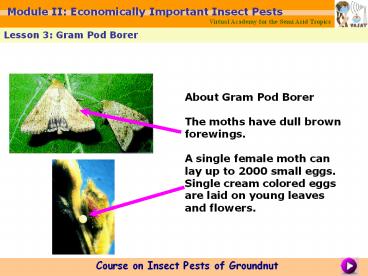Module II: Economically Important Insect Pests Virtual - PowerPoint PPT Presentation
1 / 9
Title:
Module II: Economically Important Insect Pests Virtual
Description:
Module II: Economically Important Insect Pests Virtual Academy for the Semi Arid Tropics Lesson 3: Gram Pod Borer About Gram Pod Borer The moths have dull brown ... – PowerPoint PPT presentation
Number of Views:38
Avg rating:3.0/5.0
Title: Module II: Economically Important Insect Pests Virtual
1
Module II Economically Important Insect Pests
Virtual Academy for the Semi Arid Tropics
Lesson 3 Gram Pod Borer
About Gram Pod Borer The moths have dull brown
forewings. A single female moth can lay up to
2000 small eggs. Single cream colored eggs are
laid on young leaves and flowers.
Course on Insect Pests of Groundnut
2
About Gram Pod Borer Most larvae are dark
greenish brown, but they can also be pink, cream,
or almost black. Larvae are easy to find on the
foliage as they do not hide during day time in
the soil unlike tobacco caterpillars.
3
- Crop Damage
- The larvae damage the foliage similar to tobacco
and hairy caterpillars but it prefers to feed on
flowers and buds.
4
- Crop Damage
- Young larvae enter leaf bud by making a pin-hole.
These pin-holes form mirror images on the
expanded leaf. - 25 leaf damage during the first 5o days of the
crop or presence of more than one larva per plant
are considered as economic threshold levels.
5
- Management
- Crop rotation with sorghum, maize, pearl millet
and sugarcane minimizes the infestation. - Grow sunflower as border or intercrop in
groundnut fields to serve as indicator or trap
crop.
Defoliated sunflower by Gram Pod Borer in
groundnut crop
6
- Management
- If defoliation exceeds 25, or if one or more
larva per plant are found during the first 50
days after seedling emergence, then apply
Endosulfan at 350 mL a.i./ha, Monocrotophos at
300 mL a.i./ha, or Fenvalerate at 100 mL a.i./ha
or Indoxacarb 50 ML a.i./ha or Spinosad 75 ML
a.i./ha.
7
- Management
- Large larvae may not be killed by insecticides.
Crop monitoring is advisable. - Monitor the emergence of adult moths by setting
up pheromone traps (2 per ha or 2 to 4 per
village). - Note that the crop can withstand considerable
levels of defoliation after the seeds start
developing in the pod without significant
reductions in crop yield.
8
- Management
- There are a number of ancillary control measures
such as monitoring by pheromone traps,
encouraging predators like spiders, and
installing bird perches (10/ha). - Application of nuclear polyhedrosis virus (NPV)
at 250 LE (larval equivalents)/ha.
9
Module II Economically Important Insect Pests
Virtual Academy for the Semi Arid Tropics
The Lesson 3 on Gram Pod Borer concludes. The
Lesson 4 is about Groundnut Leaf Miner that
affects groundnut crop. The subsequent Lessons
describe other economically important insect
pests in groundnut crop. Select Lesson 4 in
Module II from Course contents
Course on Insect Pests of Groundnut































